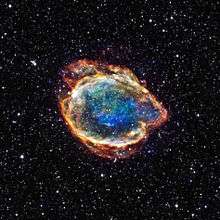Magnetar
A magnetar is a type of neutron star believed to have an extremely powerful magnetic field (∼109 to 1011 T, ∼1013 to 1015 G).[1] The magnetic field decay powers the emission of high-energy electromagnetic radiation, particularly X-rays and gamma rays.[2] The theory regarding these objects was proposed by Robert Duncan and Christopher Thompson in 1992, but the first recorded burst of gamma rays thought to have been from a magnetar had been detected on March 5, 1979.[3] During the following decade, the magnetar hypothesis became widely accepted as a likely explanation for soft gamma repeaters (SGRs) and anomalous X-ray pulsars (AXPs). On 1 June 2020, astronomers reported narrowing down the source of Fast Radio Bursts (FRBs), which may now plausibly include "compact-object mergers and magnetars arising from normal core collapse supernovae".[4][5][6]

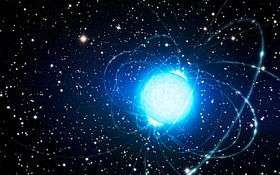
Description
Like other neutron stars, magnetars are around 20 kilometres (12 mi) in diameter and have a mass 1–2 times that of the Sun. The density of the interior of a magnetar is such that a tablespoon of its substance would have a mass of over 100 million tons.[2] Magnetars are differentiated from other neutron stars by having even stronger magnetic fields, and by rotating comparatively more quickly. Most neutron stars rotate once every one to ten seconds,[7] whereas magnetars rotate once in less than one second. A magnetar's magnetic field gives rise to very strong and characteristic bursts of X-rays and gamma rays. The active life of a magnetar is short. Their strong magnetic fields decay after about 10,000 years, after which activity and strong X-ray emission cease. Given the number of magnetars observable today, one estimate puts the number of inactive magnetars in the Milky Way at 30 million or more.[7]
Starquakes triggered on the surface of the magnetar disturb the magnetic field which encompasses it, often leading to extremely powerful gamma ray flare emissions which have been recorded on Earth in 1979, 1998, and 2004.[8]
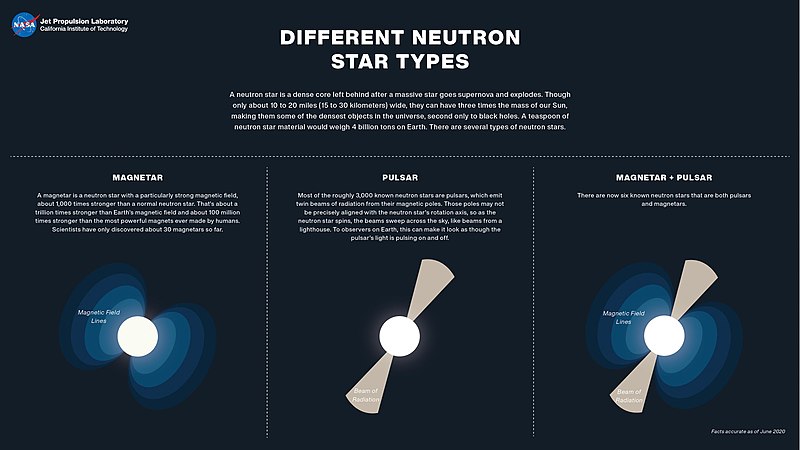
Magnetic field
Magnetars are characterized by their extremely powerful magnetic fields of ∼109 to 1011 T.[9] These magnetic fields are a hundred million times stronger than any man-made magnet,[10] and about a trillion times more powerful than the field surrounding Earth.[11] Earth has a geomagnetic field of 30–60 microteslas, and a neodymium-based, rare-earth magnet has a field of about 1.25 tesla, with a magnetic energy density of 4.0×105 J/m3. A magnetar's 1010 tesla field, by contrast, has an energy density of 4.0×1025 J/m3, with an E/c2 mass density more than 10,000 times that of lead. General relativity predicts significant spacetime bending effects due to these huge magnetic fields, but quantum considerations suggest otherwise.[12] The magnetic field of a magnetar would be lethal even at a distance of 1000 km due to the strong magnetic field distorting the electron clouds of the subject's constituent atoms, rendering the chemistry of life impossible.[13] At a distance of halfway from Earth to the moon, a magnetar could strip information from the magnetic stripes of all credit cards on Earth.[14] As of 2010, they are the most powerful magnetic objects detected throughout the universe.[8][15]
As described in the February 2003 Scientific American cover story, remarkable things happen within a magnetic field of magnetar strength. "X-ray photons readily split in two or merge. The vacuum itself is polarized, becoming strongly birefringent, like a calcite crystal. Atoms are deformed into long cylinders thinner than the quantum-relativistic de Broglie wavelength of an electron."[3] In a field of about 105 teslas atomic orbitals deform into rod shapes. At 1010 teslas, a hydrogen atom becomes a spindle 200 times narrower than its normal diameter.[3]
Origins of magnetic fields
The dominant theory of the strong fields of magnetars is that it results from a magnetohydrodynamic dynamo process in the turbulent, extremely dense conducting fluid that exists before the neutron star settles into its equilibrium configuration. These fields then persist due to persistent currents in a proton-superconductor phase of matter that exists at an intermediate depth within the neutron star (where neutrons predominate by mass). A similar magnetohydrodynamic dynamo process produces even more intense transient fields during coalescence of pairs of neutron stars.[16] But another theory is that they simply result from the collapse of stars with unusually high magnetic fields.[17]
Formation

When in a supernova, a star collapses to a neutron star, and its magnetic field increases dramatically in strength. Halving a linear dimension increases the magnetic field fourfold. Duncan and Thompson calculated that when the spin, temperature and magnetic field of a newly formed neutron star falls into the right ranges, a dynamo mechanism could act, converting heat and rotational energy into magnetic energy and increasing the magnetic field, normally an already enormous 108 teslas, to more than 1011 teslas (or 1015 gauss). The result is a magnetar.[18] It is estimated that about one in ten supernova explosions results in a magnetar rather than a more standard neutron star or pulsar.[19]
1979 discovery
On March 5, 1979, a few months after the successful dropping of satellites into the atmosphere of Venus, the two unmanned Soviet spaceprobes, Venera 11 and 12, that were then drifting through the Solar System were hit by a blast of gamma radiation at approximately 10:51 EST. This contact raised the radiation readings on both the probes from a normal 100 counts per second to over 200,000 counts a second, in only a fraction of a millisecond.[3]
This burst of gamma rays quickly continued to spread. Eleven seconds later, Helios 2, a NASA probe, which was in orbit around the Sun, was saturated by the blast of radiation. It soon hit Venus, and the Pioneer Venus Orbiter's detectors were overcome by the wave. Seconds later, Earth received the wave of radiation, where the powerful output of gamma rays inundated the detectors of three U.S. Department of Defense Vela satellites, the Soviet Prognoz 7 satellite, and the Einstein Observatory. Just before the wave exited the Solar System, the blast also hit the International Sun–Earth Explorer. This extremely powerful blast of gamma radiation constituted the strongest wave of extra-solar gamma rays ever detected; it was over 100 times more intense than any known previous extra-solar burst. Because gamma rays travel at the speed of light and the time of the pulse was recorded by several distant spacecraft as well as on Earth, the source of the gamma radiation could be calculated to an accuracy of about 2 arcseconds.[20] The direction of the source corresponded with the remnants of a star that had gone supernova around 3000 B.C.E.[8] It was in the Large Magellanic Cloud and the source was named SGR 0525-66; the event itself was named GRB 790305b, the first observed SGR megaflare.
Recent discoveries
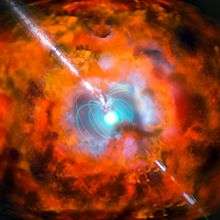
On February 21, 2008, it was announced that NASA and researchers at McGill University had discovered a neutron star with the properties of a radio pulsar which emitted some magnetically powered bursts, like a magnetar. This suggests that magnetars are not merely a rare type of pulsar but may be a (possibly reversible) phase in the lives of some pulsars.[22] On September 24, 2008, ESO announced what it ascertained was the first optically active magnetar-candidate yet discovered, using ESO's Very Large Telescope. The newly discovered object was designated SWIFT J195509+261406.[23] On September 1, 2014, ESA released news of a magnetar close to supernova remnant Kesteven 79. Astronomers from Europe and China discovered this magnetar, named 3XMM J185246.6+003317, in 2013 by looking at images that had been taken in 2008 and 2009.[24] In 2013, a magnetar PSR J1745-2900 was discovered, which orbits the black hole in the Sagittarius A* system. This object provides a valuable tool for studying the ionized interstellar medium toward the Galactic Center. In 2018, the result of the merger of two neutron stars was determined to be a hypermassive magnetar.[25]
In April 2020, a possible link between fast radio bursts (FRBs) and magnetars was suggested, based on observations of SGR 1935+2154, a likely magnetar located in the Milky Way galaxy.[26][27]
Known magnetars

As of March 2016, 23 magnetars are known, with six more candidates awaiting confirmation.[9] A full listing is given in the McGill SGR/AXP Online Catalog.[9] Examples of known magnetars include:
- SGR 0525-66, in the Large Magellanic Cloud, located about 163,000 light-years from Earth, the first found (in 1979)
- SGR 1806-20, located 50,000 light-years from Earth on the far side of the Milky Way in the constellation of Sagittarius.
- SGR 1900+14, located 20,000 light-years away in the constellation Aquila. After a long period of low emissions (significant bursts only in 1979 and 1993) it became active in May–August 1998, and a burst detected on August 27, 1998 was of sufficient power to force NEAR Shoemaker to shut down to prevent damage and to saturate instruments on BeppoSAX, WIND and RXTE. On May 29, 2008, NASA's Spitzer Space Telescope discovered a ring of matter around this magnetar. It is thought that this ring formed in the 1998 burst.[28]
- SGR 0501+4516 was discovered on 22 August 2008.[29]
- 1E 1048.1−5937, located 9,000 light-years away in the constellation Carina. The original star, from which the magnetar formed, had a mass 30 to 40 times that of the Sun.
- As of September 2008, ESO reports identification of an object which it has initially identified as a magnetar, SWIFT J195509+261406, originally identified by a gamma-ray burst (GRB 070610).[23]
- CXO J164710.2-455216, located in the massive galactic cluster Westerlund 1, which formed from a star with a mass in excess of 40 solar masses.[30][31][32]
- SWIFT J1822.3 Star-1606 discovered on 14 July 2011 by Italian and Spanish researchers of CSIC at Madrid and Catalonia. This magnetar contrary to previsions has a low external magnetic field, and it might be as young as half a million years.[33]
- 3XMM J185246.6+003317 Discovered by international team of astronomers, looking at data from ESA's XMM-Newton X-ray telescope.
- SGR 1935+2154, emitted a pair of luminous radio bursts on 28 April 2020. There was speculation that these may be galactic examples of fast radio bursts.
- Swift J1818.0-1607, x-ray burst detected March 2020, is one of five known magnetars that are also radio pulsars. It may be only 240 years old.[34]
| Magnetar—SGR J1745-2900 |
|---|
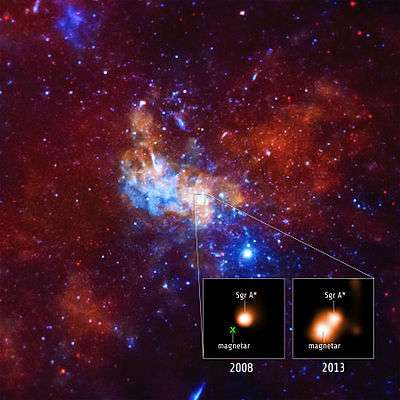 |
Bright supernovae
Unusually bright supernovae are thought to result from the death of very large stars as pair-instability supernovae (or pulsational pair-instability supernovae). However, recent research by astronomers[35][36] has postulated that energy released from newly formed magnetars into the surrounding supernova remnants may be responsible for some of the brightest supernovae, such as SN 2005ap and SN 2008es.[37][38][39]
See also
References
- Specific
- Kaspi, Victoria M.; Beloborodov, Andrei M. (2017). "Magnetars". Annual Review of Astronomy and Astrophysics. 55 (1): 261–301. arXiv:1703.00068. Bibcode:2017ARA&A..55..261K. doi:10.1146/annurev-astro-081915-023329.
- Ward; Brownlee, p.286
- Kouveliotou, C.; Duncan, R. C.; Thompson, C. (February 2003). "Magnetars Magnetars". Scientific American; Page 35.
- Starr, Michelle (1 June 2020). "Astronomers Just Narrowed Down The Source of Those Powerful Radio Signals From Space". ScienceAlert.com. Retrieved 2 June 2020.
- Bhandan, Shivani (1 June 2020). "The Host Galaxies and Progenitors of Fast Radio Bursts Localized with the Australian Square Kilometre Array Pathfinder". The Astrophysical Journal Letters. 895 (2). arXiv:2005.13160. doi:10.3847/2041-8213/ab672e. Retrieved 2 June 2020.
- Hall, Shannon (11 June 2020). "A Surprise Discovery Points to the Source of Fast Radio Bursts - After a burst lit up their telescope "like a Christmas tree," astronomers were able to finally track down the source of these cosmic oddities". Quantum Magazine. Retrieved 11 June 2020.
- "Magnetars, Soft Gamma Repeaters and Very Strong Magnetic Fields". Robert C. Duncan, University of Texas at Austin. March 2003. Archived from the original on 2007-06-11. Retrieved 2007-05-23.
- Kouveliotou, C.; Duncan, R. C.; Thompson, C. (February 2003). "Magnetars Archived 2007-06-11 at the Wayback Machine". Scientific American; Page 36.
- "McGill SGR/AXP Online Catalog". Retrieved 2 Jan 2014.
- "HLD user program, at Dresden High Magnetic Field Laboratory". Retrieved 2009-02-04.
- Naeye, Robert (February 18, 2005). "The Brightest Blast". Sky & Telescope. Retrieved 17 December 2007.
- see Nemirovsky, J.; Cohen, E.; Kaminer, I. (30 Dec 2018). "Spin Spacetime Censorship". arXiv:1812.11450v2 [gr-qc].CS1 maint: ref=harv (link) page 11 and page 18
- Duncan, Robert. "'MAGNETARS', SOFT GAMMA REPEATERS & VERY STRONG MAGNETIC FIELDS". University of Texas. Archived from the original on May 17, 2013. Retrieved 2013-04-21.
- Wanjek, Christopher (February 18, 2005). "Cosmic Explosion Among the Brightest in Recorded History". NASA. Retrieved 17 December 2007.
- Dooling, Dave (May 20, 1998). ""Magnetar" discovery solves 19-year-old mystery". Science@NASA Headline News. Archived from the original on 14 December 2007. Retrieved 17 December 2007.
- Price, Daniel J.; Rosswog, Stephan (May 2006). "Producing Ultrastrong Magnetic Fields in Neutron Star Mergers". Science. 312 (5774): 719–722. arXiv:astro-ph/0603845. Bibcode:2006Sci...312..719P. doi:10.1126/science.1125201. PMID 16574823.

- Zhou, Ping; Vink, Jacco; Safi-Harb, Samar; Miceli, Marco (September 2019). "Spatially resolved X-ray study of supernova remnants that host magnetars: Implication of their fossil field origin". Astronomy & Astrophysics. 629 (A51): 12. arXiv:1909.01922. doi:10.1051/0004-6361/201936002.

- Kouveliotou, p.237
- Popov, S. B.; Prokhorov, M. E. (April 2006). "Progenitors with enhanced rotation and the origin of magnetars". Monthly Notices of the Royal Astronomical Society. 367 (2): 732–736. arXiv:astro-ph/0505406. Bibcode:2006MNRAS.367..732P. doi:10.1111/j.1365-2966.2005.09983.x.

- Cline, T. L., Desai, U. D., Teegarden, B. J., Evans, W. D., Klebesadel, R. W., Laros, J. G. (Apr 1982). "Precise source location of the anomalous 1979 March 5 gamma-ray transient". Journal: Astrophysical Journal. 255: L45–L48. Bibcode:1982ApJ...255L..45C. doi:10.1086/183766. hdl:2060/19820012236.CS1 maint: multiple names: authors list (link)

- "Biggest Explosions in the Universe Powered by Strongest Magnets". Retrieved 9 July 2015.
- Shainblum, Mark (21 February 2008). "Jekyll-Hyde neutron star discovered by researchers]". McGill University.
- "The Hibernating Stellar Magnet: First Optically Active Magnetar-Candidate Discovered". ESO. 23 September 2008.
- "Magnetar discovered close to supernova remnant Kesteven 79". ESA/XMM-Newton/ Ping Zhou, Nanjing University, China. 1 September 2014.
- van Putten, Maurice H P M; Della Valle, Massimo (2018-09-04). "Observational evidence for extended emission to GW170817". Monthly Notices of the Royal Astronomical Society: Letters. 482 (1): L46–L49. arXiv:1806.02165. Bibcode:2019MNRAS.482L..46V. doi:10.1093/mnrasl/sly166. ISSN 1745-3925.
- Drake, Nadia (5 May 2020). "'Magnetic Star' Radio Waves Could Solve the Mystery of Fast Radio Bursts - The surprise detection of a radio burst from a neutron star in our galaxy might reveal the origin of a bigger cosmological phenomenon". Scientific American. Retrieved 9 May 2020.
- Starr, Michelle (1 May 2020). "Exclusive: We Might Have First-Ever Detection of a Fast Radio Burst in Our Own Galaxy". ScienceAlert.com. Retrieved 9 May 2020.
- "Strange Ring Found Around Dead Star".
- Francis Reddy, European Satellites Probe a New Magnetar (NASA SWIFT site, 06.16.09)
- Westerlund 1: Neutron Star Discovered Where a Black Hole Was Expected
- Magnetar Formation Mystery Solved, eso1415 - Science Release (14 May 2014)
- Wood, Chris. "Very Large Telescope solves magnetar mystery" GizMag, 14 May 2014. Accessed: 18 May 2014.
- A new low-B magnetar
- A Cosmic Baby Is Discovered, and It's Brilliant
- Kasen, D.; L. Bildsten. (1 Jul 2010). "Supernova Light Curves Powered by Young Magnetars". Astrophysical Journal. 717 (1): 245–249. arXiv:0911.0680. Bibcode:2010ApJ...717..245K. doi:10.1088/0004-637X/717/1/245.
- Woosley, S. (20 Aug 2010). "Bright Supernovae From Magnetar Birth". Astrophysical Journal Letters. 719 (2): L204–L207. arXiv:0911.0698. Bibcode:2010ApJ...719L.204W. doi:10.1088/2041-8205/719/2/L204.
- Inserra, C.; Smartt, S. J.; Jerkstrand, A.; Valenti, S.; Fraser, M.; Wright, D.; Smith, K.; Chen, T.-W.; Kotak, R.; et al. (June 2013). "Super Luminous Ic Supernovae: catching a magnetar by the tail". The Astrophysical Journal. 770 (2): 128. arXiv:1304.3320. Bibcode:2013ApJ...770..128I. doi:10.1088/0004-637X/770/2/128.
- Queen's University, Belfast (16 October 2013). "New light on star death: Super-luminous supernovae may be powered by magnetars". ScienceDaily. Retrieved 21 October 2013.
- M. Nicholl; S. J. Smartt; A. Jerkstrand; C. Inserra; M. McCrum; R. Kotak; M. Fraser; D. Wright; T.-W. Chen; K. Smith; D. R. Young; S. A. Sim; S. Valenti; D. A. Howell; F. Bresolin; R. P. Kudritzki; J. L. Tonry; M. E. Huber; A. Rest; A. Pastorello; L. Tomasella; E. Cappellaro; S. Benetti; S. Mattila; E. Kankare; T. Kangas; G. Leloudas; J. Sollerman; F. Taddia; E. Berger; R. Chornock; G. Narayan; C. W. Stubbs; R. J. Foley; R. Lunnan; A. Soderberg; N. Sanders; D. Milisavljevic; R. Margutti; R. P. Kirshner; N. Elias-Rosa; A. Morales-Garoffolo; S. Taubenberger; M. T. Botticella; S. Gezari; Y. Urata; S. Rodney; A. G. Riess; D. Scolnic; W. M. Wood-Vasey; W. S. Burgett; K. Chambers; H. A. Flewelling; E. A. Magnier; N. Kaiser; N. Metcalfe; J. Morgan; P. A. Price; W. Sweeney; C. Waters. (17 Oct 2013). "Slowly fading super-luminous supernovae that are not pair-instability explosions". Nature. 7471. 502 (346): 346–9. arXiv:1310.4446. Bibcode:2013Natur.502..346N. doi:10.1038/nature12569. PMID 24132291.
- Books and literature
- Ward, Peter Douglas; Brownlee, Donald (2000). Rare Earth: Why Complex Life Is Uncommon in the Universe. Springer. ISBN 0-387-98701-0.
- Kouveliotou, Chryssa (2001). The Neutron Star-Black Hole Connection. Springer. ISBN 1-4020-0205-X.
- Mereghetti, S. (2008). "The strongest cosmic magnets: soft gamma-ray repeaters and anomalous X-ray pulsars". Astronomy and Astrophysics Review. 15 (4): 225–287. arXiv:0804.0250. Bibcode:2008A&ARv..15..225M. doi:10.1007/s00159-008-0011-z.
- General
- Schirber, Michael (2 February 2005). "Origin of magnetars". CNN.
- Naeye, Robert (18 February 2005). "The Brightest Blast". Sky and Telescope.
External links
| Wikimedia Commons has media related to: |
- McGill Online Magnetar Catalog
- Magnetar (astronomy) at the Encyclopædia Britannica

